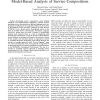19 search results - page 2 / 4 » Execution Models for Choreographies and Cryptoprotocols |
ISPW
2009
IEEE
13 years 11 months ago
2009
IEEE
Web service orchestration is popular because the application logic is defined from a central and unique point of view, but it suffers from scalability issues. In choreography, the ...
JCIT
2010
12 years 12 months ago
2010
Web Service Choreography Description Language is a main-stream standard for the description of peer-to-peer collaborations for the participants for service composition. To predict...
ICIW
2008
IEEE
13 years 11 months ago
2008
IEEE
—Developing service compositions, using multiple standards and implementation techniques, typically involves specifying service characteristics in different languages and tools. ...
EEE
2005
IEEE
13 years 10 months ago
2005
IEEE
UN/CEFACT’s Modelling Methodology (UMM) is used to analyze and design B2B business processes. We extend UMM by a constraint mechanism for adding business environment-specific co...
VLDB
2007
ACM
13 years 11 months ago
2007
ACM
The recent upsurge in the interest in Semantic Web services and the high-profile projects such as the WSMO, OWLS, and SWSL, have drawn attention to the importance of logic-based ...


